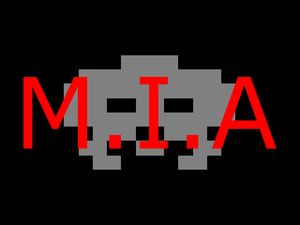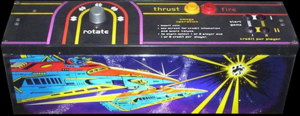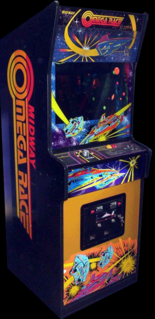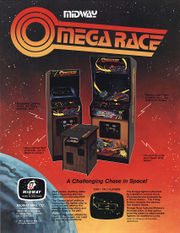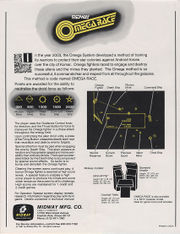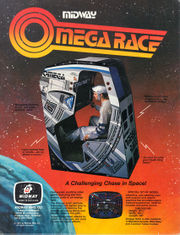Lost In Translation/Omega Race
| Omega Race | |
|---|---|
| Manufacturer | Midway |
| Released | 1981 |
| Control Method |
Dial 2 Button(s) |
| Main CPU | Z80 (@ 3.000 MHz) Z80 (@ 1.500 MHz) |
| Sound CPU | Mono (2x) AY-3-8912A (@ 1.000 MHz) |
| Video Details |
Vector (Horizontal) 0 x 0 pixels 40.00 Hz 32,768 Palette colours |
| Screens | 1 |
| ROM Info | 8 ROMs 22,784 bytes (22.25 KiB) |
| MAME ID | omegrace · deltrace |
About The Game
Omega Race is an arcade video game.
When playing this game, you are the pilot of an Omegan Space Fighter in training to defend Omega's Star Colonies. You are stationed in space to destroy as many waves of attacking enemy droid ships as possible.
You begin your training with a small number of droid ships in the first wave of attackers and gradually build your skill until there is a maximum number of 12 attacking droid ships per wave. These attaching ships not only move independently and fire at you, they also drop two different kinds of space mines to block your path and your shots at them.
As your skill level increases, the speed with which the droid ships attack is gradually increased and their shots at you become more accurate.
Bonus ships are awarded to you periodically throughout the game as you reach or pass certain preselected point values. Each enemy ship and mine has a point value.
The object of the game is to survive as long as possible while destroying as many attacking droid ships and space mines as you can. As you do this, each following wave of attackers will be harder to destroy.
Additional Technical Information
Players : 2
Control : Spinner knob
Buttons : 2 (FIRE, THRUST)
Trivia
Released in June 1981.
Omega Race was Midway's only vector game created.
Also released as :
- "Omega Race [Mini-Myte model]"
- "Omega Race [Sit-Down model]"
- "Omega Race [Cocktail model]"
According to Arcade Engineering co-founder (and former Allied Leisure designer) Jack Pearson, the idea for Omega Race came when some designers obtained a copy of Atari's "Asteroids" and created a new game by putting masking tape on the screen to create a track and they ignored the asteroids and were trying to fly around the track.
Omega Race differed significantly from "Asteroids" in a few respects. First, there was no 'wrap-around' (where you exit on one edge and return to the opposite edge). The walls would stop the player's fighter if it impacted them. Second, all the information such as high score and ships left were in a box in the middle of the playing field. Last, you could be expected to encounter multiple attackers in each wave. Although Omega Race wasn't a big seller, it still created a following. Unfortunately, this game came out when games such as "Pac-Man" were at their peak.
One thing of note is that the high score table will not display the initial FUK or FUC (early censorship at its best).
Thomas Gault holds the official record for this game with 3,290,900 points.
A bootleg of this game is known as "Delta Race".
Scoring
| Target | Points |
|---|---|
| Photon Mine | 350 |
| Vapor Mine | 500 |
| Droid Ship | 1,000 |
| Command Ship | 1,500 |
| Death Ship | 2,500 |
Tips and tricks
- When you start the game, your fighter will be in either the left or right corner of the screen. The enemy Droid Ships will be in one of the lower corners diagonally opposite from your fighter. Your job is to eliminate all the enemy Droid Ships in order to advance to the next wave. You will start with six enemy Droid Ships in wave one. The number of Droid Ships will increase by two until you will be dealing with twelve enemy Droid Ship per wave. Not only will you have to deal with enemy Droid Ships, you will also have to deal with the mines that they lay.
- The spinner knob is very sensitive on this game. That means you don't have to turn it too much to make your fighter respond. This can be very helpful if you are attempting to line up a shot and you 'overspin' the knob, thereby leaving yourself vulnerable to an enemy attack.
- Go down the side opposite of where the enemy Droid Ships are. Since you have rapid fire, try to destroy as many enemy Droid Ships as possible. This will become important in later waves since multiple Command and Death ships will appear amongst the enemy Droid Ships.
- When moving around the screen, make sure you keep firing toward the enemy ships. Although shots in this game have a limited range, if you put up a wall of fire, you can catch the enemy Command or Death ships in a nasty trap. Keep in mind that your rate of fire is only limited by how fast you can push the fire button.
- If you accelerate too much in one direction, turn your fighter toward any one of the walls so that you ram it. This will cause your fighter to instantly stop so that you can get your bearings again to deal with enemy threats.
- After the second wave, the enemy Droid Ships tend to migrate around the middle box in a direction opposite of where your fighter appears. After the fourth wave, the enemy Droid Ships tend to split up with a Command ship with each of these groups to make your job even harder.
- Command ships located in the pack of enemy Droid Ships will not pursue your fighter. This doesn't mean, however, that they aren't helpless. If you get too close to one of these packs, that Command ship will fire on your fighter.
- Enemy fire isn't the only danger you will have to deal with. Command and Death ships also deposit mines. If you don't destroy the Photon mines, they eventually become Vapor mines. Both of these mines can present a major obstacle if you are trying to get away from the enemy or trying to set yourself up into a better firing position.
- If you take too long to bring down a Command ship, it will transform into a Death ship. Death ships are much harder to hit because they fly quickly around the screen shooting and laying mines.
- Don't get to close to any Command or Death ship since both of these ships have pretty accurate fire when they get close to your fighter.
- After Wave 5, a Droid Ship will transform into a Death ship near the beginning of the wave to create an even bigger challenge of getting through the wave.
Staff
- Designed By
- Ron Halliburton (Founder of Arcade Engineering)
Cabinet and Artwork
Ports
- Consoles
- Colecovision (1981)
- Atari 2600 (1983)
- Computers
- Tandy Color Computer (1982, "Space Race")
- Commodore C64 (1982)
- Commodore VIC-20 (1982)
- Others
- VFD tabletop game (1981) by Coleco (Unreleased)


